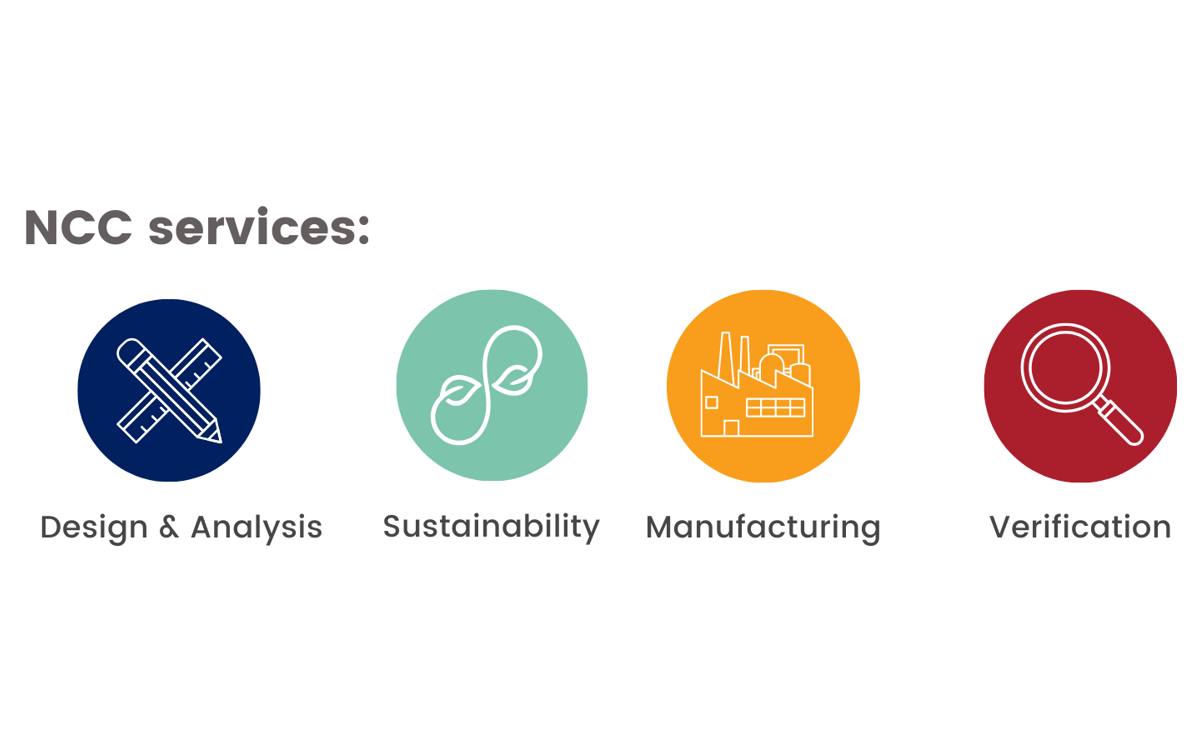
NCC, Cygnet Texkimp and B&M Longworth successfully recycle reclaimed continuous carbon fibres from composites pressure vessels
Engineers at the National Composites Centre (NCC), the UK’s centre of excellence for advanced composite applications, along with British SME partners B&M Longworth Ltd (Longworth) and Cygnet Texkimp, have successfully reclaimed continuous carbon fibres from a whole pressure vessel and re-used them to manufacture a new pressure vessel. This represents a significant milestone in the development of Britain’s hydrogen capability.
Challenge
As hydrogen gas has low energy density, it needs to be compressed and stored at very high pressures, between 350 to 700 bar (5,076 – 10,152 psi). This makes high-strength, lower-weight carbon fibre the material of choice, especially for hydrogen pressure vessels in vehicles such as cars or aircraft, where power-to-weight is critical. Demand for carbon-fibre is expected to grow five-fold between 2025 and 2030, exceeding global manufacturing capacity. Creating viable, low-cost recovery processes, that retain the inherent strength of continuous carbon fibres for recycling, is therefore key to the development of the hydrogen economy.
Results
Partnering with Lancashire-based Longworth, the NCC team successfully reclaimed continuous carbon fibre, from end-of-life composite pressure vessels, using the company’s revolutionary DEECOM® process. Originally designed to remove waste polymers from filters and production equipment, the process uses superheated steam, under compression, to penetrate microscopic fissures in the composite’s polymer, where it then condenses.
On decompression, it boils and expands, cracking the polymer and carrying away broken particles. This pressure swing cycle is then repeated until all the matrix (the material suspended in the polymer) has been separated from the fibre, allowing the monomers to also be reclaimed for possible reprocessing.

Innovation
Until recently, recycling processes for composite components such as aircraft wings and wind turbine blades has resulted in short fibres with lower mechanical properties than virgin fibre. Whilst there are applications for this material, it is not suitable for re-use in high performing products.
Longworth’s DEECOM® process leaves the primary component material intact and undamaged, allowing for any length to be retained. As a result, NCC engineers working with Cygnet Texkimp, a Cheshire-based, global leader of fibre handling and conversion technology, could use the reclaimed continuous carbon fibre to make a new pressure vessel using filament winding.
Impact
The fibre recovery and recycling project, forms part of the NCC’s Hydrogen programme, developing and sharing the technical knowledge, cross-sector composite expertise and state of the art technology that businesses need to achieve their hydrogen ambitions.
As part of this programme, NCC engineers have worked to refine composite pressure vessel designs, producing detailed design and analysis to minimise waste and trial the tools and manufacturing processes industry will use to reclaim and recycle continuous carbon fibres. They have also delivered composite design specification for cryogenic pressure vessels, which was integral in their pioneering work to design, manufacture, and test the UK’s first composite cryogenic hydrogen storage vessels.
Next steps
This groundbreaking work to reclaim continuous carbon fibres from a whole pressure vessel and reuse them to manufacture a new pressure vessel has since won the Innovation in Composites Materials award at the 2022 Composites UK Industry Awards.
The NCC, Longworth and Cygnet Texkimp are now looking to collaborate with manufacturers to scale and industrialise the process using reclaimed continuous carbon fibre, sharing the knowledge of recent recycling trials. The partnership also plans to undertake fibre characterisation analysis of the reclaimed material and recycled vessel.
Marcus Walls-Bruck, Chief Engineer for Hydrogen at the National Composites Centre says:
"Achieving continuous fibre recovery is a significant step towards our goal of a fully recyclable certified vessel – the critical technology barrier we need to address, if we are to embed hydrogen in our energy mix and meet net zero targets. We are at the stage of being able to share this expertise in fibre recovery and our extensive design exploration work for composite pressure vessels. We want to hear from companies interested in joining us on this journey to sustainable pressure vessels as we accelerate UK capabilities."
Jen Hill, Director, at B&M Longworth Ltd says:
"Following intensive R&D into the use of DEECOM® for composite reclamation and circularity, we’re excited to see successful reclamation and remanufacture of a pressure vessel. Recent projects have seen success in a range of composite panels and automotive parts, so a move towards hydrogen vessels was the next logical challenge. Thanks to insight from experts at the National Composites Centre along with the expertise of our partners at Cygnet Texkimp, we’ve achieved what several said was impossible and are already progressing to the testing stage and looking for the next challenge."
Luke Vardy, CEO at Cygnet Texkimp says:
"One of the most exciting aspects of this collaboration and the technologies it is built around is the way in which we are able to maximise the value and integrity of the fibre at every stage in the process. Not only does this technology have the potential to transform end-of-life outcomes for composites, but it also shows how we can do so without compromising the essential properties of the fibre. That commitment to fibre integrity is extremely significant because it allows us to reclaim and repurpose carbon fibre in a way that is reliable and sustainable, while creating end products of the highest quality and consistency."
The NCC is developing a state-of-the-art manufacturing and test facility for hydrogen transportation and storage, for pressure vessels and pipes, which will underpin its design, test and manufacturing capabilities. The facility already houses a pressure test system, a Filament Winder and Thermoplastic Pipe Winder.
Connect with our experts to learn more about the award-winning recycled pressure vessel and find out how we can help accelerate your composites for hydrogen ambitions: [email protected]

